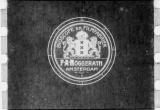The Oldest Dutch Films in the EYE Archives
The vast majority of films made in the first decennia of film history are gone. Worldwide, it’s estimated that at least 80% of all the films that were made up until WWI have been lost. This is also the case in the Netherlands.
Films with a short shelf life
Up until the emergence of film distribution and the rise of cinemas in circa 1910, film production was nearly always related to the direct screening practices of exhibitors. This was particularly true for travelling cinema showmen, who made films to supplement the film programmes they showed, which were mainly made up of purchased films. These were local films or current news events or, in a few cases, a short fiction film.
These films had a short life expectancy, as they were only interesting to the local residents. Most films could only be shown for a couple of weeks, at most. After that, they’d lost most of all of their value. It was only worth saving the film for later screenings in a very few cases, for example, if a current news item had received national attention, or when it was an exceptional film such as De mésaventure van een Fransch heertje zonder pantalon aan het strand van Zandvoort.
There’s no doubt that as time went on, these films were destroyed – after all, they were just extra ballast for travelling cinema showmen – and that’s how they were lost forever. Out of the hundreds of films by Alberts Frères, only a very few are preserved.
Preserving the leading stories of the day
It was different for cinema owners. In their circuit, the Dutch branch of the Mutoscope Maatschappij and F.A. Nöggerath’s FAN Film (affiliated with the The Warwick Trading Company) functioned as central sales and rental offices. They, too, made local and topical films that disappeared into thin air, but both Mutoscope Maatschappij and FAN Film also covered the leading stories of the day in the Netherlands.
These included the coronation and marriage of Queen Wilhelmina, the First Peace Conference in The Hague and, years later, the sinking of the SS Berlin near the Hoek van Holland. Each of these events received international attention. There were most likely multiple copies of these films made, and the majority of them have been preserved.
Oldest existing Dutch films
The largest remaining group of these films is Mutoscope Maatschappij’s 68mm collection. In total, 250 films were preserved. These were restored in the 1990s by EYE. Nöggerath’s films suffered another fate, however. His first films were destroyed when his cinema Variété Flora went up in flames on 29 August 1902. Only ten films from these early years were preserved; these were films that had multiple copies that were most likely not in Nöggerath’s possession at the time.
These eleven films, which are also located in EYE archives, were donated to the Nederlandsch Centraal Filmarchief (‘…’) in 1925 by a schoolteacher from Helder named Slingervoet Ramondt. Together with the films from Mutoscope Maatschappij, they are the oldest Dutch films that still exist.
This corpus contains the following films:
Aankomst van Paul Kruger te Amsterdam
Bezoek van President Paul Kruger te Rotterdam
De Dam te Amsterdam omstreeks 1900
De Amsterdamse Beurs omstreek 1900
De Maasbrug te Amsterdam (De Maasbrug te Rotterdam omstreeks 1901)
Intocht van hertog Hendrik van Mecklenburg en H.M. de koningin aan het Staatsspoor te 's-Gravenhage
Koninklijke Bruidstoet en Huwelijksplechtigheid
Maskeradefeesten te Utrecht in 1901
De opening van de beide kamers der Staten-Generaal door H.M. koningin Wilhelmina
Te water laten van de 'Koningin Regentes' aan de Marinewerf, 1900
more information
If you are looking for more material from our collection, please contact Film Sales:
sales@eyefilm.nl
phone +31 (0)20 5891 426

